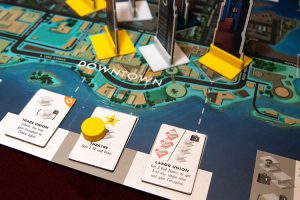 Alright fellow wealthy entrepreneurs. As I’m sure you all know, the best use of your wealth is to make more of it. And what better investment than real estate! You’ll be constructing skyscrapers throughout the city, attracting tenants to give you special abilities, and maybe participating in a little minor government corruption to keep things running smoothly.
Alright fellow wealthy entrepreneurs. As I’m sure you all know, the best use of your wealth is to make more of it. And what better investment than real estate! You’ll be constructing skyscrapers throughout the city, attracting tenants to give you special abilities, and maybe participating in a little minor government corruption to keep things running smoothly.
That’s, essentially, the premise of High Rise from Formal Ferret Games. So let’s fire up our excavators and start building.
Gameplay Overview:
The main mechanism of High Rise is one giant rondel of action spaces along the outside of the board. The action spaces are broken into zones. Whichever player is farthest back is the active player and moves to any unoccupied action space that is in another zone along the track. You’ll spend many of these actions collecting the game’s most basic resource: floors.
These floors can be turned into buildings based on the construction chart for the current round. When you place a building you earn VPs based on its height and choose where to place it on the board. The height of the building you place is, generally, equal to the number of floors it takes to construct it. However, you can earn bonus floors for being the first to build a certain blueprint, using ultraplastics (a more rare wild resource), and additional bonuses for certain power cards that can be obtained.

The building spaces line up with some of the action spaces, so when you place a building you also get to activate that action. As the game progresses if anyone uses an action where you own the corresponding building, you’ll get a random floor as a bonus. If a neighborhood is ever full of buildings you can replace the smallest building there when you build.
All of that sounds pretty basic, but one of the most interesting wrinkles here is the use of a corruption track. Many of the actions can be “powered-up” by taking on corruption. For instance, you might just get a random floor tile from the bag, but if you take a corruption you get a second tile and you can choose the color instead of leaving it up to the fates. Each build action corresponds to a certain neighborhood, but for one corruption you can build anywhere instead. All of this corruption means nothing in the short term, so it may seem like a no-brainer. But you’ll suffer penalties at the end of each round if you have the most corruption and they translate into negative victory points at the end of the game.
The other thing that happens at the conclusion of each round (when all players have made one full trip around the board) is the doling out of additional victory points. Each neighborhood will score for the tallest buildings there. In the later rounds, you’ll score for the top two or three buildings in each neighborhood. Ties are purposefully ultra-friendly, allowing all tied buildings to score the highest value and still awarding second and third place prizes if needed. So if you work out a way to tie your own building for first place you’ll get double the payout.
The game ends after a number of rounds (one for the introductory game, two for standard, three for full), and the player with the most points, after accounting for all that pesky corruption they took, is the winner.

Game Experience:
With my first play of High Rise, we started with the two-round standard game. The rulebook suggests the introductory game but I’m way too proud to let my gamer cred be tarnished with playing a watered-down version. Instead, we kind of bumbled our way through, understanding the basics, and ultimately left feeling kind of lukewarm on the experience.
So what else could a person do but jump into the full game. And we did. And it was glorious.

The full three rounds gives more room for the game to shine. The mechanisms here are simple enough for all euro board gamers to understand—collect resources (floors), turn into points (buildings). But where you place those buildings can be very important. If there is a particularly useful action space on the board, owning the building there will mean extra resources for you every time someone uses it. So maybe you’ll rush and put out a small two-story building there just to get ownership. You’ll almost assuredly get overbuilt eventually, but for now, you’ll enjoy the bonuses.
Of course, other players may be saving up for the bigger buildings. Or accumulating power cards to give them bonus points or floors on future constructions. Almost every option is useful, it is just a matter of crafting a plan and executing.
Rondels are one of my favorite mechanisms here and the last-player-goes-next method here works perfectly. Since you have to progress at least to a new zone you can’t hold back entirely. But throughout the track there are bonus tiles for the first players to pass over them, incentivizing you to maybe jump ahead farther than you would otherwise want to do, leaving other players to take their time to catch up to you.

There is plenty to keep exploring in High Rise. The game comes with 45 tenant tiles and you’ll only be using 16 at most in each game. The combinations of different actions available each play aren’t endless, but they are more than my brain can compute, so let’s just call them endless. And that doesn’t even get into the bonus tiles each round that can introduce other powers as well.
I will mention, for future plays, I would only be suggesting playing the full game to people. Honestly, I’m not sure the standard game is useful. If it’s your first play, the introductory game is a good way to get a feel for the mechanisms. The full game gives you the time you need to really explore making interesting powers work for you and taking different strategic paths. The standard game is the worst of both worlds and feels incomplete. I will say despite the rulebook suggesting the full game will take more than 2 hours, we were often very close to or under that length (and I game with a particular AP-prone group).
Final Thoughts:
If there is anything negative to say, it’s that High Rise isn’t particularly revolutionary. It fits firmly in the world of medium-weight euros where you try to make victory points. Yet, it does so with great production values, a lot of theme, and plenty of fun combos to work out each game. The friendly-tiebreaker scoring in High Rise is interesting in that you can work out ways to score first place for yourself multiple times. Corruption, rather than money and loans, works out as a wonderful (and thematic) method of spending that which you do not have.
Final Score: 4 Stars – A fun take on resource conversion with lots to explore, especially in the full game.
 Hits:
Hits:
• Tons of new bonus and tenant tiles for every game.
• Corruption track provides a great way method to get more powerful actions.
• Tiebreaker scoring is a simple change to add a bit of depth.
Misses:
• Nothing revolutionary, but a good example of what theme can do for euro games.
• Standard game length didn’t really provide enough depth.
























At first glance it seems like Monopoly meets Sims!